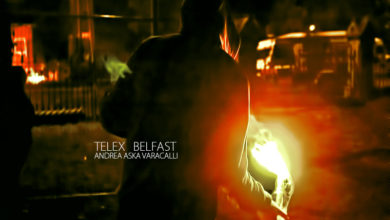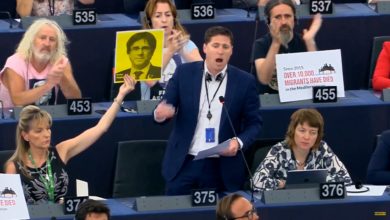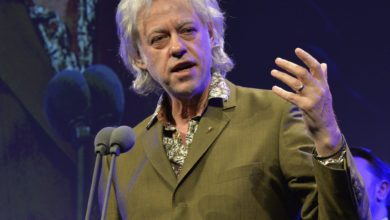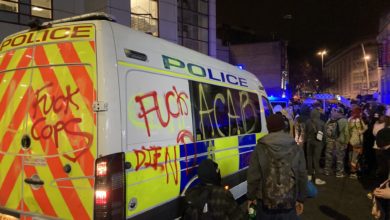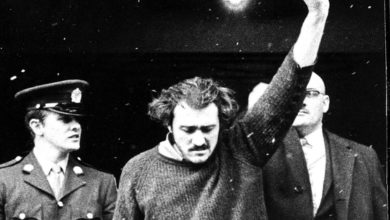Crackdown
Jim Dee, Boston, 5 february 2006
Quakers, pranksters and the entire anti-war movement are now the subject of the biggest domestic surveillance operation in the history of the United States. Jim Dee talks to Chris Pyle, the first insider to expose domestic spying by the US military in the 1960s, about the operation “which dwarfs anything that the Gestapo could have imagined”
 Revelations that George Bush authorized the ultra-secret National Security Agency to conduct domestic surveillance after 9/11 have caused an uproar across America. However, according to professor Chris Pyle, a former Army intelligence officer who was the first insider to expose domestic spying by the US military, the US public hasn’t a clue just how huge state domestic surveillance operations have really become.
Revelations that George Bush authorized the ultra-secret National Security Agency to conduct domestic surveillance after 9/11 have caused an uproar across America. However, according to professor Chris Pyle, a former Army intelligence officer who was the first insider to expose domestic spying by the US military, the US public hasn’t a clue just how huge state domestic surveillance operations have really become.
“The new surveillance, using computers and telecommunications, dwarfs anything that the CIA, the FBI, and the Army did in the 1960s,” says Pyle, during an interview with Village at his home in western Massachusetts. “It dwarfs anything that the KGB or the Gestapo could have imagined,” says Pyle. “The system of course is not run by people of the mindset of the KGB or the Gestapo, but the capabilities are greater. Today there is no privacy left.”
In March, 1968, while serving as an Army intelligence officer, Chris Pyle was given a tour of a secret facility in Baltimore that housed a staggering level of spying apparatus. At the time, he was teaching an Army intelligence course regarding things that the military needed to know in order to assist civilian authorities during riots. “And after one of these classes, a student came up to me and said ‘Captain Pyle, you don’t know much about this, do you? And I said ‘No. What can you tell me?'” His student had been a special duty officer, CONUS (Continental US) Intelligence Section, and he asked Pyle if he wanted to have a briefing arranged for him.
 “So he did. And we got our security badges and went into the labyrinth of this giant black building in Baltimore, Maryland, where they kept all the files,” said Pyle “We went down into the centre of it, where there was a steel cage in a brightly-lit room, in the centre of the room. Around the steel cage, there benches on the walls, and 13 teletype machines chattering away reports from all over the country about political activity.”
“So he did. And we got our security badges and went into the labyrinth of this giant black building in Baltimore, Maryland, where they kept all the files,” said Pyle “We went down into the centre of it, where there was a steel cage in a brightly-lit room, in the centre of the room. Around the steel cage, there benches on the walls, and 13 teletype machines chattering away reports from all over the country about political activity.”
“We were taken into the centre of the cage. And on the benches in the centre of the cage were mug-books of persons active in civil disturbances,” said Pyle “I opened volume one, and there was Ralph David Abernathy staring up at me – Martin Luther King’s assistant in the Southern Christian Leadership Conference.”
He said that further down the bench were a stack of the old-style, punch computer cards that used to feed information into computers. He said the top punch card was a report on Arlo Tatum, who was the head of the Central Committee for Conscientious (War) Objectors in Philadelphia.
Later, Pyle was shown another part of this secretive building inside Baltimore’s Fort Holabird, where “a giant library” the size of several warehouses was located. “It had so many files that they sent a cherry-picker on rails down between the aisles to pull down the files in boxes. And those files were on millions of Americans who’d engaged in political activity,” said Pyle.

Although stunned at the level of surveillance that he was seeing, Pyle lavished praise on his guides, and told them he was very impressed with their work. He asked if he could take back something to show his students. “And they proudly tore off a 5 – foot long teletype print-out, an intelligence summary for the week of March 11 through 18, 1968.”
Pyle said when he left the Baltimore building that day “I understood what I had seen. I’d seen the essential apparatus of a police state.”
“The people running it were not Gestapo, not KGB or NKVD, they were perfectly reasonable, ordinary human beings,” he added “But what they had was a reporting system that was covering all political activity in the United States. Behind that system were 1,500 agents, out of 300 offices, watching every demonstration of 20 people or more, and reporting back to Fort Holabird (Baltimore), to the US Army Intelligence Command.”
Exposure
Shortly after visiting that building in Baltimore, he left the Army, went to graduate school, and eventually he wrote a ground-breaking article detailing what he’d seen, which was published in January 1970 in the Washington Monthly magazine. He then gave the print-out he had been given at Fort Holabird to the ACLU, and a law suit ensued.
 The Pentagon created a 50-man unit dedicated to answering the allegations he’d made, along with others that would subsequently appear in the press. Those articles didn’t appear by accident. Pyle had been travelling the country enlisting several former students who were counter-intelligence officers who were also willing to spill the beans on domestic Army spying.
The Pentagon created a 50-man unit dedicated to answering the allegations he’d made, along with others that would subsequently appear in the press. Those articles didn’t appear by accident. Pyle had been travelling the country enlisting several former students who were counter-intelligence officers who were also willing to spill the beans on domestic Army spying.
“Eventually we recruited 125 counter-intelligence agents to tell what they knew to members of the Congress, to the courts, and the press,” Pyle told Village. “About every two weeks, another story would appear in the press. Drove the military crazy. They had no security. It took them four months to find out I was behind it.”
The episode earned him status on Richard Nixon’s infamous enemies list, and an Internal Revenue Service tax audit. Even that backfired on the government – it turned out the Revenue owed his wife $154.
In the end, Congress passed new legislation, with Pyle’s input, that placed new restraints on domestic spying by the US military. After the Congressional hearings, the Army relinquished all their files pertaining to domestic surveillance. Pyle spent the next three months reading every one, in order to prepare a report for a Senate committee headed by Sam Irvine, who would later chair the Watergate hearings.
Pyle said that the files showed that covert Army spying in the US had reached comic proportions. One file recounted the Army’s obsession with a group of anti-Vietnam War protesters called the Yippies, who ran a pig for president in 1968.
 “The pig’s name was Pigasus. He was a guest at the Democratic national convention,” said Pyle. “Well, Army intelligence was fascinated by Pigasus. Filed many reports. They even had a bogus television crew that interviewed the people who were keeping Pigasus. And they put the film from this interview on an airplane and sent it back to Washington so it could be viewed swiftly by the generals at the Pentagon. And in this way they sought to protect the republic from this whacky humour.”
“The pig’s name was Pigasus. He was a guest at the Democratic national convention,” said Pyle. “Well, Army intelligence was fascinated by Pigasus. Filed many reports. They even had a bogus television crew that interviewed the people who were keeping Pigasus. And they put the film from this interview on an airplane and sent it back to Washington so it could be viewed swiftly by the generals at the Pentagon. And in this way they sought to protect the republic from this whacky humour.”
He said another file focused on an anti-war protest in Colorado. “There were 119 people at this demonstration – of whom 59 were undercover government agents. The agents on the ground were trying to tape record the speakers and found their tape recordings drowned out by the guys in the helicopters overhead. It was a farce.”
9/11 changed everything
However, the events of 9/11 have dramatically changed the rules of the game. America is now at war, and Pentagon hawks are back in the ascendancy – and so too is their nonsensical brand of domestic surveillance, said Pyle
“It’s going on because most of the agents don’t speak Arabic. They can’t be of any use in spying on Al-Qaida,” he said “They have to have somebody to spy on. So they spy on people who protest government policy in the war in Iraq in the English language. Full employment for snoops.”
 “The American public is still very frightened of terrorist activity,” added Pyle, who is now a professor of politics at Mount Holyoke College in South Hadley, Massachusetts. “And even though we haven’t anything big recently, we should be concerned about it. It is a legitimate concern. But what’s going on throughout the country, and a scale which dwarfs what I encountered, is massive domestic political surveillance by police, state police, the FBI, the military, and private corporations.”
“The American public is still very frightened of terrorist activity,” added Pyle, who is now a professor of politics at Mount Holyoke College in South Hadley, Massachusetts. “And even though we haven’t anything big recently, we should be concerned about it. It is a legitimate concern. But what’s going on throughout the country, and a scale which dwarfs what I encountered, is massive domestic political surveillance by police, state police, the FBI, the military, and private corporations.”
“A month ago I examined some military intelligence files put together by an organization called the Counter-Intelligence Field Activity,” he said “It employs over 1,000 people. It has nine directors. It monitors any civilian political activity that arguably might threaten military personnel, military bases, and so forth – which means the entire anti-war movement.”
Pyle was asked to look at the new files by NBC, who had obtained the secret Department of Defense documents. The files provide the first glimpse of exactly how much the US military has ratcheted up its domestic intelligence gathering operations since the 9/11 attacks.
“Those 400 pages that I read were summary reports, eight to ten to a page, of incidents around the country that the organisation thought was a threat to the military – including a number of anti-war groups like the Quakers, whose meetings were infiltrated,” says Pyle.
 “There is a defensiveness within the intelligence and the military community that treats all criticism of the war, and intelligence work, and torture, as a kind of subversive activity,” he said. “They feel this bitterly. And so they regard these protesters as the enemy, or they regard them as the running dogs and fellow travellers of the enemy.”
“There is a defensiveness within the intelligence and the military community that treats all criticism of the war, and intelligence work, and torture, as a kind of subversive activity,” he said. “They feel this bitterly. And so they regard these protesters as the enemy, or they regard them as the running dogs and fellow travellers of the enemy.”
Pyle says that there is a place for some surveillance in society, such as those involving law enforcement investigations. “There is not a place for the J. Edgar Hoover memorial vacuum-cleaner – indiscriminate collection on anybody who criticises government policy, ” he says.
As an example of the current indiscriminate nature of intelligence collection, Pyle cited the case of a student at the University of Massachusetts at Dartmouth who, this fall, ordered Mao’s little red book on inter-library loan. He was promptly visited by agents from the Department of Homeland Security.
“This system is based upon the assumption that the way you find a needle in a haystack is to add more hay,” insisted Pyle. “The way that you connect the dots is to put so damn many dots on the page, that the page turns black, and then you think you’ve found something. You haven’t. You have utterly obscured the very thing you are looking for.”
“Intelligence operatives, and strike forces, and SWAT teams, are all trained to deal with a stereotypic situation,” he said. “But when the situation doesn’t fit the stereotype, they re-define the situation so that it will. Every bureaucracy is a solution in search of a problem. And if the problem doesn’t fit their solution, they redefine the problem. And you get a lot of bizarre behaviour because of that.”
 “And this is happening all over the world, when you talk about NSA. NSA is located in Great Britain – a huge intercept facility in Great Britain. In New Zealand, Australia, Canada, on ships at sea, all communications all over the world are subject to its vacuum-cleaner and its dictionary of watch-listed terms. So, it’s not just Americans who ought to be concerned about this.”
“And this is happening all over the world, when you talk about NSA. NSA is located in Great Britain – a huge intercept facility in Great Britain. In New Zealand, Australia, Canada, on ships at sea, all communications all over the world are subject to its vacuum-cleaner and its dictionary of watch-listed terms. So, it’s not just Americans who ought to be concerned about this.”
Pyle said his “greatest nightmare” is that “if we have another attack, all bets are off. All power will flow to the president from a frightened people, and there’ll be no stopping the measures to destroy civil liberties.”
 Jim Dee, autorevole giornalista americano, è stato dalla metà degli anni ’80 fino al 2004 corrispondente da Belfast del Boston Herald e di altre testate di primissimo piano in USA.
Jim Dee, autorevole giornalista americano, è stato dalla metà degli anni ’80 fino al 2004 corrispondente da Belfast del Boston Herald e di altre testate di primissimo piano in USA.

